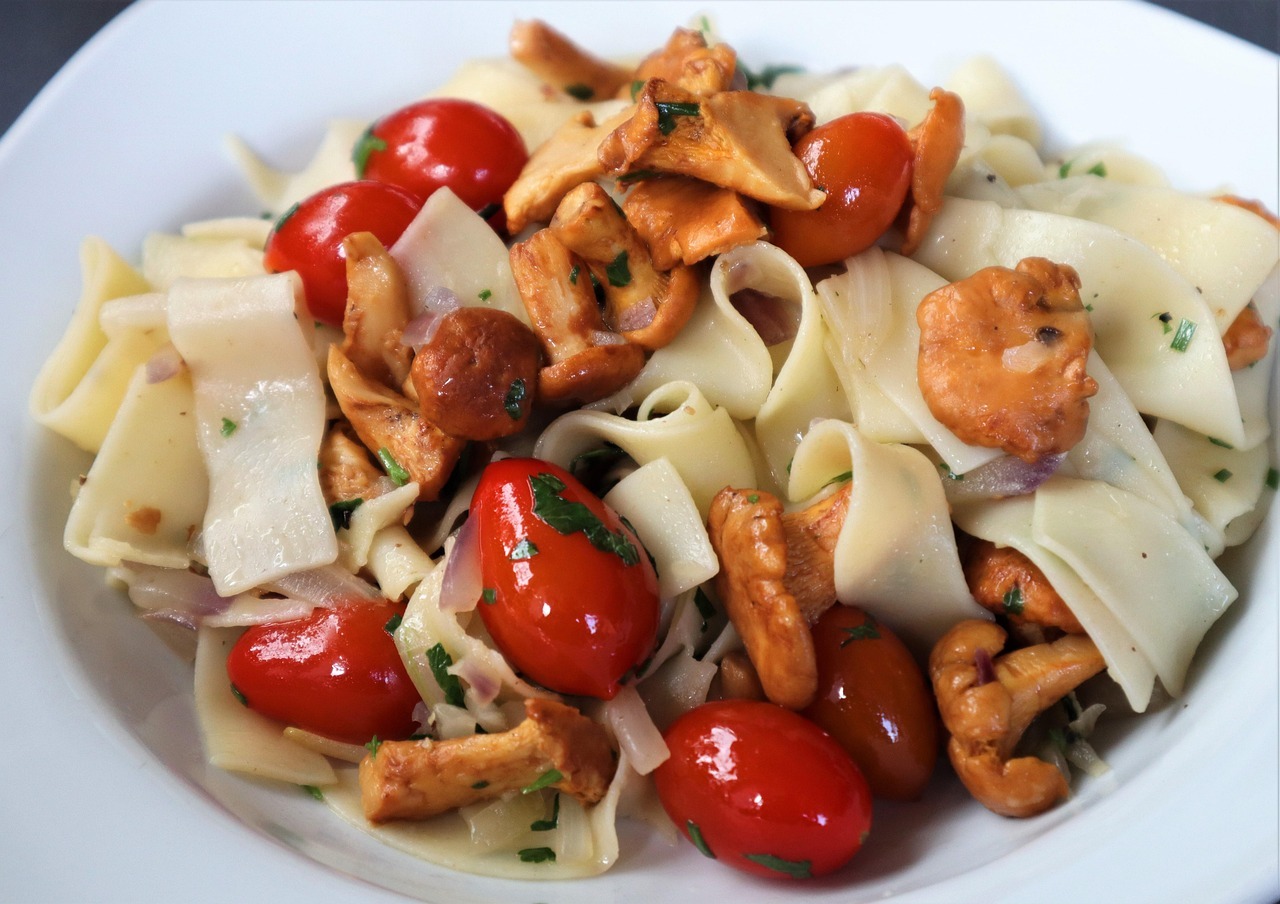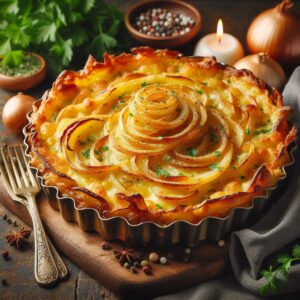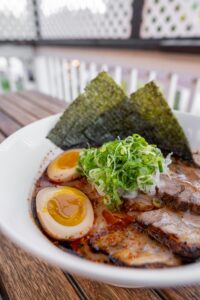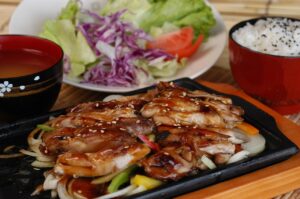Discovering the Soul of Simple Cooking
In the world of pasta, where complexity often reigns supreme, this dish stands as a testament to the power of restraint. What begins as a handful of everyday ingredients transforms into something that speaks directly to your senses—the deep, honeyed richness of slowly cooked onions dancing with the electric heat of carefully crafted chili oil.
This recipe isn’t about shortcuts or quick fixes. It’s about understanding that the best flavors emerge when we give them time to develop, when we respect the process, and when we allow simple ingredients to reveal their hidden depths.
Essential Components
Core Ingredients
- 16 oz your favorite pasta shape (ribbon pastas like tagliatelle shine here)
- 4 medium yellow onions, cut into thin crescents
- 4 tablespoons unsalted butter
- 2 tablespoons good olive oil
- 4 cloves garlic, minced to a paste
- 1 tablespoon fresh thyme leaves
- 1/2 cup dry white wine
- 1 cup freshly grated aged Parmesan
- Coarse salt and freshly ground pepper
Chili Oil Components
- 3/4 cup extra virgin olive oil
- 2 tablespoons red chili flakes
- 2 garlic cloves, paper-thin slices
- 1/2 teaspoon sweet paprika
- 1/4 teaspoon fine sea salt
Final Flourishes
- Fresh herbs for brightness (parsley, chives, or basil)
- Additional Parmesan for the table
- Crispy fried garlic or shallots (optional luxury)
Understanding the Timeline
Preparation: 15 minutes of focused knife work
Cooking: 50 minutes of mostly hands-off time
Assembly: 10 minutes of active finishing
The rhythm of this dish teaches patience. While modern cooking often emphasizes speed, this recipe rewards those who understand that some things simply cannot be rushed.
The Cooking Journey
Stage One: The Slow Dance of Caramelization
Begin with a large, heavy pan—cast iron or enameled steel work beautifully. Melt your butter with the olive oil over medium-low heat until it foams gently. Add your sliced onions along with a generous pinch of salt, stirring to coat each piece.
Now comes the meditation of cooking: let these onions cook undisturbed for 5-7 minutes before your first gentle stir. Continue this rhythm—stirring occasionally, letting them work their magic in between. Over the next 35-40 minutes, you’ll witness alchemy as the onions release their moisture, concentrate their sugars, and transform into something almost jam-like in consistency.
Stage Two: Building the Heat
As your onions slowly transform, turn your attention to the chili oil. In a small, heavy-bottomed saucepan, combine your olive oil with the chili flakes, garlic slices, paprika, and salt. Place over the lowest possible heat and let it warm gently for 8-10 minutes. You’re looking for the gentlest of bubbles—never a vigorous simmer that would turn the garlic bitter.
Remove from heat and let this aromatic oil continue to steep, growing more complex with each passing minute.
Stage Three: The Pasta Foundation
While your onions near completion, bring a large pot of well-salted water to a rolling boil. Cook your pasta until it’s just shy of perfectly al dente—it will finish cooking in the sauce. Before draining, capture at least one full cup of that precious pasta water, rich with starch that will help bind your sauce.
Stage Four: The Marriage of Flavors
When your onions have reached that perfect state of golden-brown sweetness, create a well in the center and add your minced garlic and thyme. Let them sizzle and become fragrant for about a minute before pouring in the wine. This will deglaze the pan, lifting all those caramelized bits that have developed on the bottom.
Add your drained pasta directly to the onion mixture, along with about half of your reserved pasta water. Using tongs or a large spoon, toss everything together over medium heat, adding more pasta water gradually until you achieve a glossy, unified sauce that clings to each strand.
Stage Five: The Final Touch
Remove the pan from heat and shower the pasta with your grated Parmesan, tossing quickly to melt the cheese into the warm sauce. Taste and adjust seasoning—you may need more salt or a crack of fresh pepper.
Presentation That Honors the Dish
Warm your serving bowls—this simple step makes an enormous difference. Divide the pasta among the bowls, creating gentle nests that show off the golden onions nestled among the strands. Drizzle each portion with your homemade chili oil, adjusting the amount to each diner’s heat preference.
Finish with torn fresh herbs and offer additional cheese at the table. The visual contrast of the golden pasta against the vibrant red oil creates a dish that’s as beautiful as it is delicious.
Nutritional Wisdom
Each generous serving delivers approximately 580 calories, with a satisfying balance of complex carbohydrates, healthy fats, and moderate protein. The slow-cooked onions contribute natural prebiotics and antioxidants, while the olive oil provides heart-healthy monounsaturated fats.
Customization Options
For Health-Conscious Adaptations
- Replace half the pasta with roasted spaghetti squash strands
- Choose ancient grain pasta varieties for increased fiber and protein
- Incorporate baby spinach or kale during the final toss
- Add cannellini beans for plant-based protein
For Enhanced Richness
- Fold in crispy pancetta or guanciale
- Top with grilled shrimp or scallops
- Include roasted cherry tomatoes for acidity
- Finish with a drizzle of aged balsamic vinegar
Beverage Harmony
This dish pairs beautifully with wines that can handle both the sweetness of the onions and the heat of the chili oil. Consider a medium-bodied Sangiovese, a crisp Vermentino, or for something unexpected, a light Beaujolais served slightly chilled.
Professional Techniques
Low and Slow: Never rush the onion cooking process. High heat creates bitter, burnt flavors rather than the sweet complexity you’re seeking.
Proper Deglazing: When adding wine to the caramelized onions, scrape vigorously to incorporate all the flavorful fond from the pan bottom.
Pasta Water Technique: Add the starchy cooking liquid gradually, tossing constantly to create an emulsified sauce that coats each strand perfectly.
Temperature Management: Remove the pan from heat before adding cheese to prevent it from becoming stringy or grainy.
Make-Ahead Strategy
The beauty of this dish lies in its components’ ability to be prepared in advance. Caramelize your onions up to five days ahead, storing them covered in the refrigerator. The chili oil actually improves over time, developing more complex flavors when made a day or two in advance.
For busy weeknights, this advance preparation reduces your active cooking time to just 15 minutes—the time it takes to cook pasta and bring everything together.
Solving Common Challenges
Onions cooking unevenly: Ensure your pan is large enough to accommodate all the onions in roughly a single layer. Overcrowding leads to steaming rather than proper caramelization.
Sauce breaking: If your sauce appears oily or separated, remove from heat and whisk in a splash of cold pasta water to re-emulsify.
Heat level concerns: Start with less chili oil than you think you need—you can always add more, but you can’t take it back.
The Philosophy Behind the Plate
This dish embodies a cooking philosophy that values process over speed, quality over quantity. It teaches us that the most memorable meals often come from the simplest foundations, treated with respect and given the time they deserve.
In our rush-filled world, taking the time to properly caramelize onions becomes almost a form of meditation—a chance to slow down, pay attention, and create something beautiful from basic ingredients.
Closing Reflections
What makes this pasta special isn’t any single component, but rather the harmony achieved when each element is given its due attention. The sweet depth of properly caramelized onions, the bright heat of carefully made chili oil, and the satisfying comfort of perfectly cooked pasta create a dish that satisfies on multiple levels.
This is food that connects us to traditional cooking methods while remaining thoroughly modern in its appeal. It’s a reminder that some of the best things in cooking—and in life—are worth waiting for.







